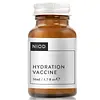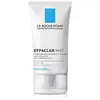What's inside
What's inside
 Key Ingredients
Key Ingredients

 Benefits
Benefits

 Concerns
Concerns

No concerns
 Ingredients Side-by-side
Ingredients Side-by-side

Caprylyl Methicone
Skin ConditioningWater
Skin ConditioningPEG-12 Dimethicone/PPG-20 Crosspolymer
Glycerin
HumectantPropanediol
SolventSodium Polyacrylate
AbsorbentLeontopodium Alpinum Callus Culture Extract
AntioxidantDisodium Acetyl Glucosamine Phosphate
Skin ConditioningProline
Skin ConditioningAlanine
MaskingSerine
MaskingGlucose
HumectantXylitol
HumectantXylitylglucoside
HumectantAnhydroxylitol
HumectantAdansonia Digitata Fruit Extract
EmollientPolypodium Vulgare Rhizome Extract
HumectantCetraria Islandica Thallus Extract
HumectantSphagnum Magellanicum Extract
Skin ConditioningPseudoalteromonas Ferment Extract
HumectantTocopherol
AntioxidantTocopheryl Acetate
AntioxidantMangifera Indica Seed Butter
Skin ConditioningOrbignya Oleifera Seed Oil
EmollientSqualane
EmollientLecithin
EmollientPhenethyl Disiloxane
Skin ConditioningTrimethylsiloxysilicate
EmollientCyclopentasiloxane
EmollientDimethicone
EmollientPolysilicone-11
Dimethicone/Vinyl Dimethicone Crosspolymer
Skin ConditioningHydroxyethyl Acrylate/Sodium Acryloyldimethyl Taurate Copolymer
Emulsion StabilisingXanthan Gum
EmulsifyingCaprylyl Glycol
EmollientSodium Benzoate
MaskingPotassium Sorbate
PreservativeCitric Acid
BufferingSodium Phosphate
BufferingSodium Hydroxide
BufferingEthylhexylglycerin
Skin ConditioningPhenoxyethanol
PreservativeChlorphenesin
AntimicrobialCaprylyl Methicone, Water, PEG-12 Dimethicone/PPG-20 Crosspolymer, Glycerin, Propanediol, Sodium Polyacrylate, Leontopodium Alpinum Callus Culture Extract, Disodium Acetyl Glucosamine Phosphate, Proline, Alanine, Serine, Glucose, Xylitol, Xylitylglucoside, Anhydroxylitol, Adansonia Digitata Fruit Extract, Polypodium Vulgare Rhizome Extract, Cetraria Islandica Thallus Extract, Sphagnum Magellanicum Extract, Pseudoalteromonas Ferment Extract, Tocopherol, Tocopheryl Acetate, Mangifera Indica Seed Butter, Orbignya Oleifera Seed Oil, Squalane, Lecithin, Phenethyl Disiloxane, Trimethylsiloxysilicate, Cyclopentasiloxane, Dimethicone, Polysilicone-11, Dimethicone/Vinyl Dimethicone Crosspolymer, Hydroxyethyl Acrylate/Sodium Acryloyldimethyl Taurate Copolymer, Xanthan Gum, Caprylyl Glycol, Sodium Benzoate, Potassium Sorbate, Citric Acid, Sodium Phosphate, Sodium Hydroxide, Ethylhexylglycerin, Phenoxyethanol, Chlorphenesin
Water
Skin ConditioningGlycerin
HumectantDimethicone
EmollientIsocetyl Stearate
EmollientAlcohol Denat.
AntimicrobialSilica
AbrasiveDimethicone Crosspolymer
Emulsion StabilisingAcrylamide
Sodium Acryloyldimethyltaurate Crosspolymer
Emulsion StabilisingVp/Va Copolymer
Methyl Methacrylate
Methyl Methacrylate Crosspolymer
Butylene Glycol
HumectantPEG-100 Stearate
Cocamide Mea
EmulsifyingSarcosine
Skin ConditioningGlyceryl Stearate
EmollientTriethanolamine
BufferingIsohexadecane
EmollientPerlite
AbsorbentCapryloyl Salicylic Acid
ExfoliatingTetrasodium EDTA
Pentylene Glycol
Skin ConditioningPolysorbate 80
EmulsifyingAcrylates/C10-30 Alkyl Acrylate Crosspolymer
Emulsion StabilisingSalicylic Acid
MaskingParfum
MaskingWater, Glycerin, Dimethicone, Isocetyl Stearate, Alcohol Denat., Silica, Dimethicone Crosspolymer, Acrylamide, Sodium Acryloyldimethyltaurate Crosspolymer, Vp/Va Copolymer, Methyl Methacrylate, Methyl Methacrylate Crosspolymer, Butylene Glycol, PEG-100 Stearate, Cocamide Mea, Sarcosine, Glyceryl Stearate, Triethanolamine, Isohexadecane, Perlite, Capryloyl Salicylic Acid, Tetrasodium EDTA, Pentylene Glycol, Polysorbate 80, Acrylates/C10-30 Alkyl Acrylate Crosspolymer, Salicylic Acid, Parfum
 Reviews
Reviews

Ingredients Explained
These ingredients are found in both products.
Ingredients higher up in an ingredient list are typically present in a larger amount.
Dimethicone is a type of synthetic silicone created from natural materials such as quartz.
What it does:
Dimethicone comes in different viscosities:
Depending on the viscosity, dimethicone has different properties.
Ingredients lists don't always show which type is used, so we recommend reaching out to the brand if you have questions about the viscosity.
This ingredient is unlikely to cause irritation because it does not get absorbed into skin. However, people with silicone allergies should be careful about using this ingredient.
Note: Dimethicone may contribute to pilling. This is because it is not oil or water soluble, so pilling may occur when layered with products. When mixed with heavy oils in a formula, the outcome is also quite greasy.
Learn more about DimethiconeGlycerin is already naturally found in your skin. It helps moisturize and protect your skin.
A study from 2016 found glycerin to be more effective as a humectant than AHAs and hyaluronic acid.
As a humectant, it helps the skin stay hydrated by pulling moisture to your skin. The low molecular weight of glycerin allows it to pull moisture into the deeper layers of your skin.
Hydrated skin improves your skin barrier; Your skin barrier helps protect against irritants and bacteria.
Glycerin has also been found to have antimicrobial and antiviral properties. Due to these properties, glycerin is often used in wound and burn treatments.
In cosmetics, glycerin is usually derived from plants such as soybean or palm. However, it can also be sourced from animals, such as tallow or animal fat.
This ingredient is organic, colorless, odorless, and non-toxic.
Glycerin is the name for this ingredient in American English. British English uses Glycerol/Glycerine.
Learn more about GlycerinWater. It's the most common cosmetic ingredient of all. You'll usually see it at the top of ingredient lists, meaning that it makes up the largest part of the product.
So why is it so popular? Water most often acts as a solvent - this means that it helps dissolve other ingredients into the formulation.
You'll also recognize water as that liquid we all need to stay alive. If you see this, drink a glass of water. Stay hydrated!
Learn more about Water